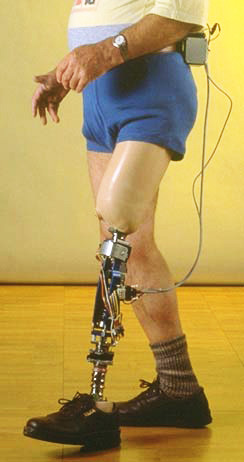Giving Prosthetic Limbs The Sense Of Touch
When I was a child I dreamt about one day becoming a biomedical engineer. And, somewhere in my mother's attic lies the remnants of that dream in the form of school papers and crayon drawings of the limbs, heads, and torsos that I one day hoped to design, engineer, and implant on human beings and animals. Aside from making me the creepiest kid in the neighborhood this also provided me with a special way of thinking about the interconnections and relationships between machines and people. That dream ultimately evaporated in college when I chose to start monetizing my software development hobby instead of completing my inorganic chemistry studies.
Today however actual biomedical engineers have come one step close to the giving a sense of touch to prosthetics for humans.  Existing robotic prostheses have limited motor control, provide no sensory feedback and can be uncomfortable to wear. In an effort to make a prosthesis that moves like a normal hand, researchers at the University of Michigan (U-M) have bioengineered a scaffold that is placed over severed nerve endings like a sleeve and could improve the function of prosthetic hands and possibly restore the sense of touch for injured patients.
Existing robotic prostheses have limited motor control, provide no sensory feedback and can be uncomfortable to wear. In an effort to make a prosthesis that moves like a normal hand, researchers at the University of Michigan (U-M) have bioengineered a scaffold that is placed over severed nerve endings like a sleeve and could improve the function of prosthetic hands and possibly restore the sense of touch for injured patients.
To overcome the limitations of existing prostheses, the U-M researchers realized a better nerve interface was needed to control the upper extremity prostheses. So they created what they called an “artificial neuromuscular junction” composed of muscle cells and a nano-sized polymer placed on a biological scaffold. Neuromuscular junctions are the body's own nerve-muscle connections that enable the brain to control muscle movement.
When a hand is amputated, the nerve endings in the arm continue to sprout branches, growing a mass of nerve fibers that send flawed signals back to the brain. The bioengineered scaffold was placed over the severed nerve endings like a sleeve. The muscle cells on the scaffold and in the body bonded and the body's native nerve sprouts fed electrical impulses into the tissue, creating a stable nerve-muscle connection.
In laboratory rats, the bioengineered interface relayed both motor and sensory electrical impulses and created a target for the nerve endings to grow properly. This indicates that the interface may not only improve fine motor control of prostheses, but can also relay sensory perceptions such as touch and temperature back to the brain. Laboratory rats with the interface responded to tickling of feet with appropriate motor signals to move the limb.
The research project, which was funded by the Department of Defense, arose from a need for better prosthetic devices for troops wounded in Afghanistan and Iraq. The DoD and the Army have already provided $4.5 million in grants to support the research. Meanwhile, the University of Michigan research team has submitted a proposal to the Defense Advance Research Project Agency (DARPA) to begin testing the bioengineered interface in humans in three years.
